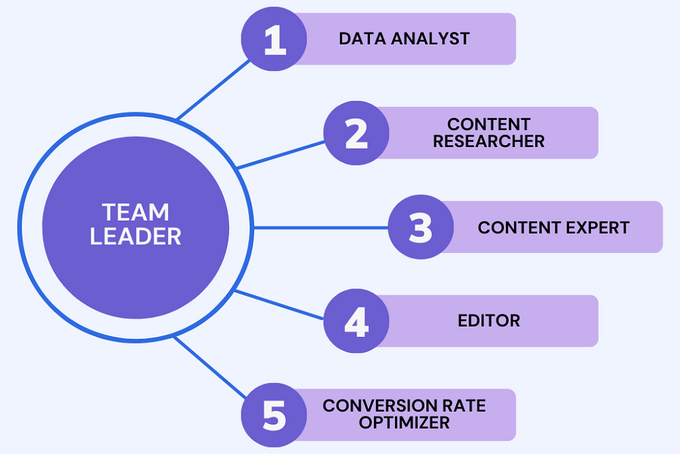Strategies for building and managing high-performing SEO content teams
SEO is key to getting your website seen, and developing a high-impact SEO content team is the first step to success.
Published June 13, 2024

Key takeaways
- Build a structured SEO content team based on resources and objectives.
- Bolster management with clear communication, goal setting, and updated documentation.
- Tackle challenges like aligning with client goals, managing writers, navigating delays, and creating content for niche markets.
- Stay competitive with a culture of continuous learning, collaboration, and innovation.
A top-notch SEO content team is the key to maintaining a competitive edge, but building and leading the team can be challenging. The right strategies and best practices can help you take obstacles in your stride and guide your team to success.
We will explore who you need in the team, what they do, how to manage your team to ensure business objectives are achieved, and how to overcome a range of common issues that crop up.
Key roles and responsibilities within an SEO content team
The structure and size of your content team depend on your resources and what you want your content team to achieve ultimately. Consider that up to 36% of content teams consist of only 1-3 people, meaning you don't have to accumulate high content creation costs initially.
Below is our suggested structure for an SEO content team:
Their roles can be broken down as follows:
| Role | Responsibilities |
|---|---|
| Team leader | Oversees all the other roles in the team. Ensures high-quality content is delivered on schedule. |
| Data analyst | Identifies high-potential content topics for ranking, clicks, and conversions. Uses machine learning and expertise to analyze data. |
| Content researcher | Delves into the chosen topics. Formulates how to produce posts that outrank currently published content. |
| Content expert | Shares personal insights, lived experiences, and unique perspectives in content. |
| Editor | Refines and transforms the expert's work into engaging SEO-optimized content. |
| Conversion rate optimizer | Examines articles pre- and post-publication. Optimizes posts to ensure better conversions. |
» Find out how to hire and manage a remote content team.
Best practices to manage an SEO content team
So, you've got your team together, but managing them effectively is the only way to ensure they perform well.
1. Effective communication with and between the team
Effective communication is the core of managing any team—even more so if you operate remotely. It's important that everyone on the team understands their roles and has a clear vision of what they're working towards.
You can improve communication through:
- Regular meetings: Meetings don't necessarily have to be daily but frequent enough to keep everyone aligned and sharing ideas.
- Communication and project management tools: We use platforms like Slack for instant communication and Monday.com for project management. This ensures that everyone understands their tasks, deadlines, and priorities.
2. Establish clear goals for the team at every step
Clear goals go hand-in-hand with effective communication. Over 57% of organizations don't have a clear goal for their content, resulting in unsuccessful communication and content execution.
Naturally, the primary goal is to deliver all content on time. But beyond that, you can also have performance goals, such as ensuring published posts attract traffic and drive conversions.
You can set up clear goals by:
- Establishing a communication chain: Communicate goals to team leaders, who then relay them to the rest of the team.
- Breaking down goals into different stages: Starting with the end point and working backward can make it easier to manage a project. This way, you can set overall monthly goals and break those down into weekly and daily objectives.
3. Keep source documents up to date
Documentation is crucial, both for current employees to refer back to but also for new employees to learn. It can be difficult for newcomers to acclimatize, and things can often slip through the cracks, meaning you have to set additional time aside for corrections.
Useful documents you can have on hand include:
- Style guides: This can help maintain consistency and high standards across all work produced for clients.
- Content templates: Templates can include structures for different types of content, such as blog posts, landing pages, and social media posts.
- Brand guidelines: This includes visual and verbal elements that define your company's or a client's brand identity, like logo usage, typography, color palette, and tone of voice.
How to overcome common challenges
Several challenges can come up in the process of managing your team. It is important to be aware of the potential challenges and be prepared with solutions to help you overcome them.
1. Aligning with a client's goals
Coordinating your content team's and client's goals can be challenging. It's vital to remember that to clients, their websites are their passion projects, and they want to be involved in every aspect. So, maintaining professional standards while ensuring client satisfaction can be a balancing act.
Possible solutions:
- Communicating openly with clients
- Providing a roadmap for the future to help manage client expectations, e.g., outlining plans for the next three to six months
2. Managing expert writers
Working with expert writers—particularly freelancers—requires a lot of work, especially when they're unresponsive or have difficulty accepting criticism. This can influence your ability to meet deadlines.
Possible solutions:
- Establishing clear expectations and deadlines from the beginning
- Regularly communicating feedback to help keep writers engaged and motivated
- Having backup writers ensures you stay on track if there are unforeseen issues with a writer's availability or responsiveness
» Hire domain experts to create high-quality content.
3. Dealing with the delay between work and results
Often, the impact of your content efforts isn't evident until three to six months later. This delay can be challenging for clients, especially in the early stages when results may be minimal.
Possible solutions:
- Keeping clients informed and satisfied during this waiting period
- Regularly sharing progress updates and providing insights into the process
- Emphasizing the long-term benefits of SEO
4. Managing clients in niche markets
Clients who operate in highly specialized markets have different needs. For example, if your client sells software exclusively to airline companies, their potential user base may consist of about 50 individuals globally. In this case, investing heavily in traditional SEO strategies may seem impractical. Plus, it can be difficult to find expert writers to produce specialized content.
Possible solutions:
- Shifting focus to creating high-quality content that enhances their brand image and expertise
- Establishing clear objectives and KPIs upfront to manage client expectations
- Collaborating with thought leaders to generate high-value content
» Explore our proven strategies for sourcing experts.
Fostering continuous learning and growth
Staying updated with the latest advancements, especially with the rapid progress of AI-driven technologies, is vital to maintain a competitive edge.
1. Emphasize continuous learning
To keep up with the industry, it's essential for every team member to adopt a mindset of continuous learning. Learning should be a daily practice, with an awareness that new information and techniques emerge frequently. Encourage your team to read articles, listen to podcasts, and gather insights from diverse sources.
2. Foster collaboration and knowledge sharing
Encourage open discussions, brainstorming sessions, and regular knowledge shares within your team. You can also try hosting competitions and events to stimulate research and idea generation. By fostering a collaborative environment, you ensure everyone contributes to the team's collective growth.
3. Establish a research and development (R&D) team
To balance the need for innovation with reaching your delivery goals, establish a dedicated R&D team separate from the deliverables team. This team focuses on researching and developing new processes, methodologies, and tools.
By having a dedicated R&D team, you ensure that innovation occurs without disrupting ongoing content production. This also helps to achieve smoother transitions when new methods are applied across the wider team.
» Discover how guest posting can still be a valuable asset in your content strategy.
Setting up your SEO content team for success
For your SEO and content creation to thrive, your content team must embrace continuous learning, adaptability, and innovation. Overcoming challenges like aligning with client goals, managing writers, addressing result delays, and catering to niche markets requires proactive strategies. Encouraging a culture of growth, collaboration, and knowledge sharing empowers your team to stay ahead of industry trends.
By nurturing these qualities, your content team can achieve long-term success and stay competitive in the face of constant updates and new technology.










